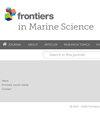与海上风力发电场共存的浮动太阳能结构引起的水动力变化
IF 3
2区 生物学
Q1 MARINE & FRESHWATER BIOLOGY
引用次数: 0
摘要
浮动光伏装置(FPV)是新兴的海洋可再生能源系统之一,有助于未来的全球能源转型战略。fpv可以集成到现有的海上风力发电场中,有助于更有效地利用海洋空间。这种互补性越来越受到人们的关注,因为它是一种可持续的方法,可以提高绿色能源生产,同时降低海上电网基础设施成本,尤其是在北海。该研究首次评估了部署在北海比利时部分现有海上风电场(OWF)中的fpv(高架设计)的中远场水动力效应。三维水动力模型COHERENS采用亚网格尺度的参数化方法,评估了对四个关键水动力指标的影响:遮阳导致的表面辐照度降低、水流速度场的变化、湍流动能的产生以及水流诱导的底部剪切应力的变化。比较了四种场景:无结构的基线,只有海上风力涡轮机的场景和两种风能和光伏组合配置(稀疏和密集)。在农场规模上,模拟显示FPV遮光对海面温度的影响很小(0.1°C),但显著降低了洋流速度,增加了主要在漂浮物下方的湍流动能,并对底部剪切应力产生了显著影响。这项水动力学建模研究是对fpv进行全面环境影响评估的第一步,特别是关于它们对水柱和底栖生物栖息地的生物地球化学影响。研究结果为支持北海及其他地区的可持续海洋空间规划、环境评估和工业设计策略提供了有价值的见解。本文章由计算机程序翻译,如有差异,请以英文原文为准。
Hydrodynamic alterations induced by floating solar structures co-located with an offshore wind farm
Floating photovoltaic installations (FPV) are among the promising emerging marine renewable energy systems contributing to future global energy transition strategies. FPVs can be integrated within existing offshore wind farms, contributing to more efficient use of marine space. This complementarity has gained increasing attention as a sustainable approach to enhance green energy production while reducing offshore grid infrastructure costs, particularly in the North Sea. This study presents a first assessment to quantify the mid- and far-field hydrodynamic effects of FPVs (elevated design) deployed within an existing offshore wind farm (OWF) in the Belgian part of the North Sea. A subgrid-scale parameterization was adopted into the 3D hydrodynamic model COHERENS to assess impacts on four key hydrodynamic metrics: surface irradiance reduction due to shading, changes in current velocity fields, turbulent kinetic energy production, and variations in current-induced bottom shear stress. Four scenarios were compared: a baseline without structures, a scenario with only offshore wind turbines and two combined wind and photovoltaic configurations (sparse and dense). At farm scale, simulations showed small effects of FPV shading on sea surface temperature (< 0.1°C), but significant reductions in current speed, increased turbulent kinetic energy mainly beneath the floaters, and a noticeable impact on bottom shear stress. This hydrodynamic modeling study constitutes a first step toward a comprehensive environmental impact assessment of FPVs, particularly in relation to their biogeochemical effects on the water column and benthic habitats. The findings provide valuable insights to support sustainable marine spatial planning, environmental assessments, and industrial design strategies in the North Sea and beyond.
求助全文
通过发布文献求助,成功后即可免费获取论文全文。
去求助
来源期刊

Frontiers in Marine Science
Agricultural and Biological Sciences-Aquatic Science
CiteScore
5.10
自引率
16.20%
发文量
2443
审稿时长
14 weeks
期刊介绍:
Frontiers in Marine Science publishes rigorously peer-reviewed research that advances our understanding of all aspects of the environment, biology, ecosystem functioning and human interactions with the oceans. Field Chief Editor Carlos M. Duarte at King Abdullah University of Science and Technology Thuwal is supported by an outstanding Editorial Board of international researchers. This multidisciplinary open-access journal is at the forefront of disseminating and communicating scientific knowledge and impactful discoveries to researchers, academics, policy makers and the public worldwide.
With the human population predicted to reach 9 billion people by 2050, it is clear that traditional land resources will not suffice to meet the demand for food or energy, required to support high-quality livelihoods. As a result, the oceans are emerging as a source of untapped assets, with new innovative industries, such as aquaculture, marine biotechnology, marine energy and deep-sea mining growing rapidly under a new era characterized by rapid growth of a blue, ocean-based economy. The sustainability of the blue economy is closely dependent on our knowledge about how to mitigate the impacts of the multiple pressures on the ocean ecosystem associated with the increased scale and diversification of industry operations in the ocean and global human pressures on the environment. Therefore, Frontiers in Marine Science particularly welcomes the communication of research outcomes addressing ocean-based solutions for the emerging challenges, including improved forecasting and observational capacities, understanding biodiversity and ecosystem problems, locally and globally, effective management strategies to maintain ocean health, and an improved capacity to sustainably derive resources from the oceans.
 求助内容:
求助内容: 应助结果提醒方式:
应助结果提醒方式:


